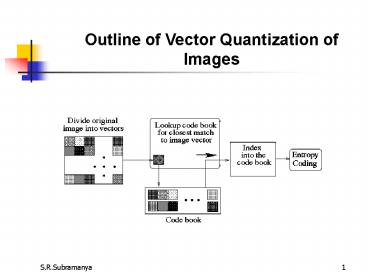Outline of Vector Quantization of Images - PowerPoint PPT Presentation
1 / 23
Title:
Outline of Vector Quantization of Images
Description:
Codebook : Cartesian product of many smaller codebooks ... codebooks. Each codebook for a specific feature. ex. edges, smooth areas, etc. Codebooks could ... – PowerPoint PPT presentation
Number of Views:339
Avg rating:3.0/5.0
Title: Outline of Vector Quantization of Images
1
Outline of Vector Quantization of Images
2
VQ Coding Outline
- Divide data (signal) into non-overlapping
vectors - (Each vector contains n elements
(pixels/samples)) - For each image vector
- Find closest vector in codebook
- Get its index in codebook
- Encode indices
3
VQ Decoding Outline
- Entropy decode the indices
- Lookup codebook for each index and retrieve
vector - Combine vectors to reconstruct image (data)
4
VQ Terminology
- Vector Group of n elements (pixels/samples)
- Codebook (Final) set of codevectors
- Training set (Initial) set of codevectors
- Codevector Vector derived from image/group of
images
5
Why VQ is better than scalar Quantization
- Scalar Quantizer
- Treats each pixel independently
- Does not use correlation between neighboring
pixels
- Vector Quantizer
- Image (data) divided into vectors (blocks)
- Correlation among pixels in vectors is exploited
- Block size should be appropriate
- Too large block correlation is lost
- Too small block More code vectors
- If no interpixel correlation, then no gain
6
VQ Bitrate
- Vector size n (say, n p x p) pixels
- Codebook size L vectors
- Codebook index size bits
- Bit Rate of VQ bits/pixel
7
Distortion Measures
Codebook
Image
V1
codevectors Vi ,
xk
V2
closest matching code vector
Vk
Image vectors Xj
VL
Mean Square Error (MSE) (Euclidean Distance)
Weighted MSE
8
Two Basic Kinds of Codebook
- Local Codebook
- One codebook for each image
- Codebook derived from vectors of one image
- Good performance (Quality of reconstruction)
- More overhead
- (1) computation
- (2) Transmission of CB to decoder
9
Two Basic Kinds of Codebook
- Global Codebook
- One codebook for a class of images
- Codebook derived from vectors of all images in
the class - Less overhead (compared to local codebook)
- Lower performance
10
Major Issues in VQ
- Generation (construction) of codebook
- concerns what needs to be included in the
codebook
- Design of codebook
- concerns structuring codebook entries to
minimize search time
11
Codebook Generation
- Generate codebook from a Training set
- Training Set Set of vectors derived from image
vectors - Codevectors should minimize distortion
- Most commonly used algorithm LBG algorithm
- LBG LindeBuzoGray algorithm
12
LBG Algorithm Outline
13
Codebook Initialization
- Three basic schemes
- Random
- Perturb and Split (Bottoming)
- Pairwise Nearest Neighbor (PNN) clustering (PNN)
14
Codebook Design
- Basic objective Minimize search time for
codevector - Full (Exhaustive) Search very expensive
- Design emphasis Organization of codebook
15
Codebook Organizations
- Tree-structured codebook
- Product codebook
- Mean/Residual VQ
- Interpolative/Residual VQ
- Gain/Shape VQ
- Classified VQ
- Finite State VQ
16
Tree Structured Codebook
- Codebook organized as Mary tree
- Number of Levels
- Code vectors stored at the leaves
- Intermediate node average of codevectors
of children - Improved search time
- Increased Storage cost
- Performance inferior to full search
17
Variations of Tree Structured VQ
- Tapered trees
- Non Uniform number of branches at nodes
- Branches per node increases going down the tree
- ( Ex 2 branches at level 1, 3 at level 2 etc.)
- Pruned Trees
- Start with (full) large initial tree
- Remove code vectors that do not reduce distortion
18
Product Codebook
- Codebook Cartesian product of many smaller
codebooks - Vector characterized by many independent
featuresf1,f2...,fN - Separate codebook for each feature
- Smaller codebbok sizes L1,L2...,LN
- Effective codebook size L1,L2...,LN
- Actual storage search complexity
O(L1L2...LN)
19
Prediction/Residual Class VQ
- Predict Original Image
- Derive Residual Image
- Data used in prediction Scalar Quantization
Encoding - Residual Image Vector Quantization
- Major Types
- Mean/Residual VQ
- Interpolative/Residual VQ
20
Mean/Residual VQ
- Image Vectors have similar variations about
different mean/ends - Remove mean from vectors fewer code vectors
21
Mean/Residual VQ
- Scheme
- Compute mean of image vectors
Mm1,m2...,mN - Quantize M using scalar quantization
- (Apply DPCM before Quantization further
bitrate reduction) - Subtract Quantized means from vector elements
- Residual vectors
- Quantize Residual vectors using VQ
22
Interpolative/Residual VQ
- Subsample original image by l in each dimension
(typically, l8) - Quantize subsampled value
- Upsample using Quantized subsampled values
(typically, bilinear interpolation is used) - Form Residual (Original Upsampled)
- Segment Residual to form 4 x 4 vectors
- Quantize Residual vectors using VQ
23
Classified VQ
- Several codebooks
- Each codebook for a specific feature
- ex. edges, smooth areas, etc.
- Codebooks could be of different sizes































